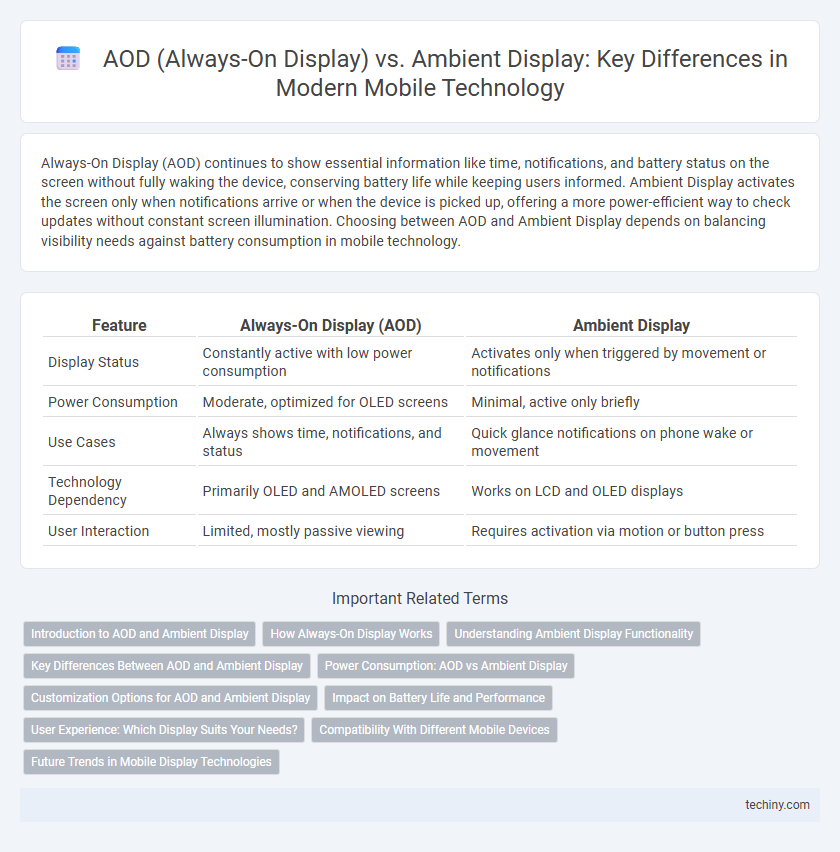Always-On Display (AOD) continues to show essential information like time, notifications, and battery status on the screen without fully waking the device, conserving battery life while keeping users informed. Ambient Display activates the screen only when notifications arrive or when the device is picked up, offering a more power-efficient way to check updates without constant screen illumination. Choosing between AOD and Ambient Display depends on balancing visibility needs against battery consumption in mobile technology.
Table of Comparison
| Feature | Always-On Display (AOD) | Ambient Display |
|---|---|---|
| Display Status | Constantly active with low power consumption | Activates only when triggered by movement or notifications |
| Power Consumption | Moderate, optimized for OLED screens | Minimal, active only briefly |
| Use Cases | Always shows time, notifications, and status | Quick glance notifications on phone wake or movement |
| Technology Dependency | Primarily OLED and AMOLED screens | Works on LCD and OLED displays |
| User Interaction | Limited, mostly passive viewing | Requires activation via motion or button press |
Introduction to AOD and Ambient Display
Always-On Display (AOD) technology enables smartphones to show key information like time, notifications, and battery status continuously on the screen with minimal power consumption using OLED or AMOLED panels. Ambient Display activates the screen temporarily with limited information when the phone is moved or receives notifications, conserving battery by avoiding full screen illumination. Both features enhance user convenience by providing quick access to essential data without fully unlocking the device.
How Always-On Display Works
Always-On Display (AOD) works by utilizing low-power OLED or AMOLED screens to show essential information like time, notifications, and battery status without fully waking the device. It employs a minimal refresh rate and grayscale or monochrome graphics to conserve battery while keeping key data visible. Unlike Ambient Display, which activates only when the device is picked up or receives a notification, AOD remains constantly active with minimal power consumption.
Understanding Ambient Display Functionality
Ambient Display functionality allows smartphones to illuminate only essential notifications and time information on a dimmed screen, conserving battery life compared to traditional Always-On Display (AOD). By activating the display only when movement or notifications are detected, ambient display optimizes power efficiency while providing users with glanceable information. This selective activation contrasts with AOD's constant screen illumination, enabling more effective energy management in mobile devices.
Key Differences Between AOD and Ambient Display
Always-On Display (AOD) continuously shows essential information such as time, notifications, and battery status on the screen with minimal power consumption, leveraging OLED or AMOLED technology for energy efficiency. Ambient Display activates the screen temporarily when a notification arrives or the device is picked up, offering limited visibility without staying constantly lit. AOD provides persistent accessibility to key data, while Ambient Display emphasizes power saving by activating only on specific triggers.
Power Consumption: AOD vs Ambient Display
Always-On Display (AOD) consumes more power than Ambient Display because it continually lights up parts of the screen, often using OLED technology to show time or notifications without fully waking the device. Ambient Display activates the screen only briefly when triggered by motion or notifications, significantly reducing power consumption by limiting active pixels and display duration. Optimizing AOD settings, such as reducing brightness and refresh rate, can mitigate battery drain compared to the more sporadic power use of Ambient Display settings.
Customization Options for AOD and Ambient Display
Always-On Display (AOD) offers extensive customization options, enabling users to personalize clock styles, color themes, widgets, and notifications, providing a visually rich and interactive experience while the screen remains active. In contrast, Ambient Display typically features limited customization, with basic notification previews and minimal graphical elements designed to conserve battery life. The enhanced personalization capabilities of AOD cater to users seeking a balance between aesthetic appeal and functional convenience on mobile devices.
Impact on Battery Life and Performance
Always-On Display (AOD) consumes more battery power than Ambient Display due to continuous screen illumination and real-time information updates, typically reducing battery life by approximately 3-5% per hour on OLED screens. Ambient Display activates only when motion or notifications are detected, significantly conserving energy and optimizing performance by limiting active screen time. Device models with OLED or AMOLED panels benefit most from AOD efficiency, while LCD screens show less savings, impacting overall performance and user experience.
User Experience: Which Display Suits Your Needs?
Always-On Display (AOD) offers continuous screen visibility, enabling users to check time, notifications, and battery status without unlocking the device, which enhances convenience but may consume more battery. Ambient Display activates only when motion or notifications are detected, optimizing battery life while providing timely information access. Choosing between AOD and Ambient Display depends on your priority for battery efficiency versus constant accessibility and personalized interaction with your mobile device.
Compatibility With Different Mobile Devices
Always-On Display (AOD) requires OLED or AMOLED screens for true pixel-level illumination control, limiting its compatibility primarily to high-end smartphones. Ambient Display functions on a broader range of devices, including LCD screens, by temporarily lighting essential pixels to show notifications without fully activating the display. This broader compatibility makes Ambient Display a versatile option across budget and mid-range mobile devices lacking advanced screen technologies.
Future Trends in Mobile Display Technologies
Always-On Display (AOD) technology enables mobile devices to show key information continuously without significant battery drain, leveraging advancements in low-power OLED and LTPO panels. Ambient Display, while traditionally limited to notifications during device wake-up gestures, is evolving with AI-driven contextual awareness to enhance user interaction without full screen activation. Future trends point toward integrating AOD with adaptive brightness, personalized content delivery, and biometric sensors, enabling smarter, energy-efficient, and more secure mobile display experiences.
AOD (Always-On Display) vs Ambient Display Infographic

 techiny.com
techiny.com